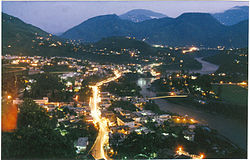Muzaffarabad
Muzaffarabad er den administrative hovedstaden i Azad Kashmir, den delen av Kashmir som er kontrollert av Pakistan.[1] Den ligger i Muzaffarabad-distriktet, som har ca.725,000 innbyggere. Byen og området ble i 2005 rammet av et jordskjelv som drepte over 87000 mennesker.[2]
| Muzaffarabad | |||
|---|---|---|---|
 | |||
| Land | |||
| Ligger ved | Neelum River Jhelum | ||
| Areal | 1 642 kvadratkilometer | ||
| Befolkning | 96 000 | ||
| Bef.tetthet | 58,47 innb./kvadratkilometer | ||
| Høyde o.h. | 737 meter | ||
| Nettside | www | ||
 Muzaffarabad 34°22′12″N 73°28′16″Ø | |||

Referanser
rediger- ^ The application of the term "administered" to the various regions of Kashmir and a mention of the Kashmir dispute is supported by the tertiary sources (a) through (e), reflecting due weight in the coverage. Although "controlled" and "held" are also applied neutrally to the names of the disputants or to the regions administered by them, as evidenced in sources (h) through (i) below, "held" is also considered politicized usage, as is the term "occupied," (see (j) below). (a) Kashmir, region Indian subcontinent, Encyclopaedia Britannica, https://www.britannica.com/place/Kashmir-region-Indian-subcontinent, besøkt 15 August 2019 (subscription required) Quote: "Kashmir, region of the northwestern Indian subcontinent ... has been the subject of dispute between India and Pakistan since the partition of the Indian subcontinent in 1947. The northern and western portions are administered by Pakistan and comprise three areas: Azad Kashmir, Gilgit, and Baltistan, the last two being part of a territory called the Northern Areas. Administered by India are the southern and southeastern portions, which constitute the state of Jammu and Kashmir but are slated to be split into two union territories."; (b) Pletcher, Kenneth, Aksai Chin, Plateau Region, Asia, Encyclopaedia Britannica, https://www.britannica.com/place/Aksai-Chin, besøkt 16 August 2019 (subscription required) Quote: "Aksai Chin, Chinese (Pinyin) Aksayqin, portion of the Kashmir region, at the northernmost extent of the Indian subcontinent in south-central Asia. It constitutes nearly all the territory of the Chinese-administered sector of Kashmir that is claimed by India to be part of the Ladakh area of Jammu and Kashmir state."; (c) «Kashmir», Encyclopedia Americana, Scholastic Library Publishing, 2006, s. 328, , https://books.google.com/books?id=l_cWAQAAMAAJ&pg=PA328 C. E Bosworth, the University of Manchester Quote: "KASHMIR, kash'mer, the northernmost region of the Indian subcontinent, administered partlv by India, partly by Pakistan, and partly by China. The region has been the subject of a bitter dispute between India and Pakistan since they became independent in 1947"; (d) Osmańczyk, Edmund Jan (2003), Encyclopedia of the United Nations and International Agreements: G to M, Taylor & Francis, ss. 1191–, , https://books.google.com/books?id=fSIMXHMdfkkC&pg=PA1191 Quote: "Jammu and Kashmir: Territory in northwestern India, subject to a dispute between India and Pakistan. It has borders with Pakistan and China." (e) Talbot, Ian (2016), A History of Modern South Asia: Politics, States, Diasporas, Yale University Press, ss. 28–29, , https://books.google.com/books?id=eNg_CwAAQBAJ&pg=PA28 Quote: "We move from a disputed international border to a dotted line on the map that represents a military border not recognized in international law. The line of control separates the Indian and Pakistani administered areas of the former Princely State of Jammu and Kashmir."; (f) Skutsch, Carl (2015), «China: Border War with India, 1962», i: Ciment, James, Encyclopedia of Conflicts Since World War II (2nd utgave), London and New York: Routledge, s. 573, , «The situation between the two nations was complicated by the 1957–1959 uprising by Tibetans against Chinese rule. Refugees poured across the Indian border, and the Indian public was outraged. Any compromise with China on the border issue became impossible. Similarly, China was offended that India had given political asylum to the Dalai Lama when he fled across the border in March 1959. In late 1959, there were shots fired between border patrols operating along both the ill-defined McMahon Line and in the Aksai Chin.» (g) Clary, Christopher (2022), The Difficult Politics of Peace: Rivalry in Modern South Asia, Oxford and New York: Oxford University Press, s. 109, , «Territorial Dispute: The situation along the Sino-Indian frontier continued to worsen. In late July (1959), an Indian reconnaissance patrol was blocked, "apprehended," and eventually expelled after three weeks in custody at the hands of a larger Chinese force near Khurnak Fort in Aksai Chin. ... Circumstances worsened further in October 1959, when a major class at Kongka Pass in eastern Ladakh led to nine dead and ten captured Indian border personnel, making it by far the most serious Sino-Indian class since India's independence.» (h) Bose, Sumantra (2009), Kashmir: Roots of Conflict, Paths to Peace, Harvard University Press, ss. 294, 291, 293, , https://books.google.com/books?id=3ACMe9WBdNAC&pg=PA294 Quote: "J&K: Jammu and Kashmir. The former princely state that is the subject of the Kashmir dispute. Besides IJK (Indian-controlled Jammu and Kashmir. The larger and more populous part of the former princely state. It has a population of slightly over 10 million, and comprises three regions: Kashmir Valley, Jammu, and Ladakh.) and AJK ('Azad" (Free) Jammu and Kashmir. The more populous part of Pakistani-controlled J&K, with a population of approximately 2.5 million.), it includes the sparsely populated "Northern Areas" of Gilgit and Baltistan, remote mountainous regions which are directly administered, unlike AJK, by the Pakistani central authorities, and some high-altitude uninhabitable tracts under Chinese control." (i) Fisher, Michael H. (2018), An Environmental History of India: From Earliest Times to the Twenty-First Century, Cambridge University Press, s. 166, , https://books.google.com/books?id=kZVuDwAAQBAJ&pg=PA166 Quote: "Kashmir’s identity remains hotly disputed with a UN-supervised “Line of Control” still separating Pakistani-held Azad (“Free”) Kashmir from Indian-held Kashmir."; (j) Snedden, Christopher (2015), Understanding Kashmir and Kashmiris, Oxford University Press, s. 10, , https://books.google.com/books?id=5amKCwAAQBAJ&pg=PA10 Quote:"Some politicised terms also used to describe parts of J&K. These terms include the words 'occupied' and 'held'."
- ^ Lundbo, Sten (2. september 2024). «Azad Kashmir». Store norske leksikon (på norsk). Besøkt 21. oktober 2024.
Denne artikkelen er en spire. Du kan hjelpe Wikipedia ved å utvide den.